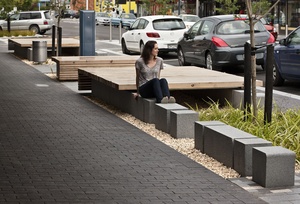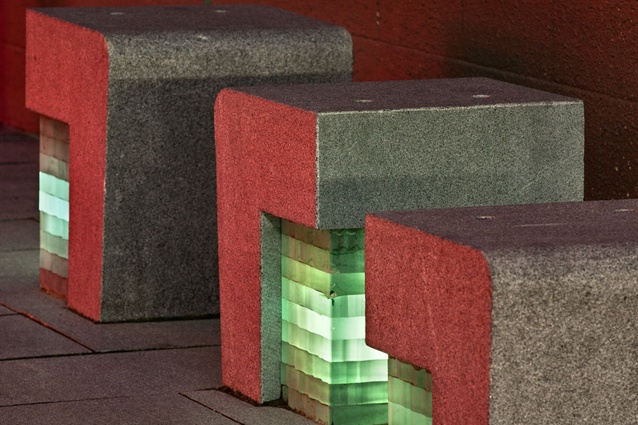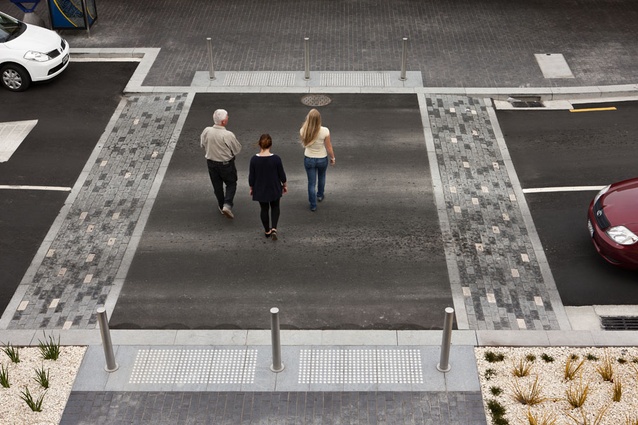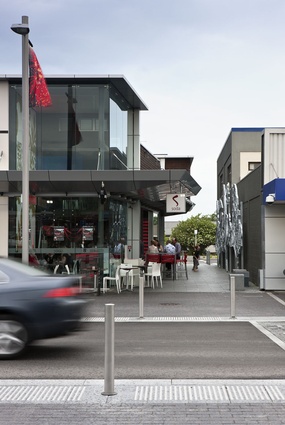Words on the street
Members of Isthmus Group’s urban design team head back to their home district – the Hawkes Bay – to give Taradale’s high street a high quality make over.
Situated ten minutes drive inland from the Art Deco city of Napier, and in amongst some of the Hawkes Bay’s most established wineries, Taradale is a suburban town centre with a strong landscape context and sense of place. Major changes to the retail mix of the town centre following relocation of the supermarket and library out of the main shopping street spurred discussions with stakeholders on the future direction of the town centre to ensure that it remained a vibrant community and retail destination.
Isthmus was initially engaged by Napier City Council to assist with stakeholder consultation and prepare a concept masterplan for the redevelopment of the laneways, car parking areas and main shopping areas, and to assist in Council’s stakeholder consultation. Project landscape architect Sarah Bishop had grown up in Taradale and once worked in the aforementioned supermarket; Isthmus director Gavin Lister also grew up in Taradale, so good experience of the landscape and the people was evident in the design team.

A small prototype project, ‘Soda Lane’, was the first step in the physical upgrade of the town centre. This project involved close collaboration between the Napier City Council and local property owner Ross Beaton. The existing 1.6m wide alleyway ran 26m between blank concrete block walls to connect the main shopping street to the car park and Town Hall on Lee Road. This key to improving this pedestrian link was the removal of the end bay of the old Mitre10 store, and the complete redevelopment of the site with a steel and glass two storey cafe and bar that extends an active edge along the full length of the laneway. The widened lane has been paved with stone with inset lighting strips and seating cubes made from granite with glass recycled from the old Napier aquarium. The laneway features a 16m long galvanised steel sculpture by a local artist collective which references stories of local people and landscape.
This catalytic project met with intense interest from the community and was a potent example of the potential of Taradale to update its retail and social mix. A significant improvement was made in the smallest of urban spaces; the laneway dramatically improved pedestrian safety and connections in the town centre and helped build momentum towards the next stages of the town centre upgrade.
Subsequently Napier City Council and the community approved the most extensive of the redevelopment options for the town centre – a major upgrade funded by the introduction of parking charges. The Lee Road car park was redeveloped to create a green and pedestrian-friendly space with clear structure and safe pedestrian routes, improved lighting, new seating, and tree and shrub planting. The new layout and pedestrian amenity encourage active frontage to the backs of the existing shop buildings and integrates the Town Hall with new footpaths, building threshold treatments and tree planting reuniting it with its urban context.
The main shopping street – Gloucester Street – was the next stage to be completed. The new street layout accommodates vehicles and easy car parking while shifting the priority of movement to pedestrians. A linear street arrangement was set up with street trees down each site and new lighting poles placed asymmetrically down the eastern side. Traffic speed is controlled by the visual narrowing of the street with trees and by the broad, raised pedestrian crossings. The central area of the street has been designed as a flexible space that provides seating and shade off-line from the main pedestrian movement, and is able to be closed down to traffic to be used for events such as farmers markets and summer wine festivals.

A key component of the design process was the construction of a 1:1 scale model of the proposed palette of materials for the street. This full scale “slice” of the street enabled council officers and councillors to see (and unanimously approve) exactly how the layout and materials selection would come together. “Warmth and colour” were strongly desired in the street; Isthmus prepared materials options and the Council specified that clay pavers were to be used. A neutral paving palette of blue-grey clay pavers with granite accents was developed with colour coming from the floral planting and banners, and warmth from large hardwood timber platforms and benches. The street has undergone a full rebuild with new granite kerbs, high quality street lighting and stormwater and services upgrades.
The construction was carefully managed by council engineers, a role traditionally undertaken by the main contractor. Proactive communication with retailers and sub-contractors saw the project completed on budget and several months ahead of schedule without any major issues. The town centre upgrade has been extremely well received by the community, retailers and Council, creating a walkable centre with a compact structure and a well-connected network of streets and pedestrian lanes.













